Monday, August 31, 2009
Tumor Streetlight
Walima Club:Iraqi cuisine(Egg plant Wraps,Date balls and Cardamom cookies,yum!)
Iraqi cuisine
Iraqi cuisine or Mesopotamian cuisine is Iraq's traditional cuisine developed since antiquity in MeMesopotamia (Sumer, Akkad, Babylonia, Assyria). It is considered one of the oldest kitchens.
As Baghdad became the centre of the Abbasid Caliphate during the Islamic Golden Age, Muslims and other scholars from many parts of the world came to visit, live and study in Iraq, which gave the Iraqi cuisine new twists to its food. This is most commonly seen in the greater use of spices (e.g. Saffron) used in the Iraqi cuisine in comparison to other Arab cuisines.
Iraqi cuisine has absorbed influences from all the neighboring countries and has much in common with Levantine, Persian, and Turkish cuisines. With the Ottoman rule of Iraq, influences of Turkish cuisine also became incorporated into Iraqi recipes (and vice versa).
Furthermore, as the rest of Iraqi history, the Iraqi cuisine has been deeply influenced by its fertile land between its two rivers Euphrates and Tigris.[1] This influence is seen in Iraq's national dishes.
Lissan Al Kadi - Eggplant wraps

The wraps turned out to be one of best tasting eggplant appetizer.Usually made with minced meat ,but one can also stuff with vegetable like mushrooms or with tofu and flavor up with choicest spices.
Recipe
Makes about 12 pieces
Ingredients:
1 large eggplants
1 tablespoon Olive oil
Meat Stuffing:
1/2 lb Lean ground meat(lamb or beef),
1 garlic ,minced
1 teaspoon cumin
1/2 teaspoon chili powder
1 medium onion (1 cup) finely minced,
1 tsp salt,
1/4 tsp black pepper
Vegetarian Stuffing :
1/2 red or green bell peppers,chopped
1 medium red onion, chopped
2 medium portobello mushrooms,sliced
1 garlic, chopped
1 teaspoon cumin
1/2 teaspoon chili powder
1/2 cup low fat crumbled feta cheese or shred mozzarella
1 teaspoon olive oil
salt and pepper for seasoning
Sauce:
1 tbsp olive oil,
1 large onion diced,
1 large tomato peeled and chopped,
8 oz. tomato sauce,
1 cup beef or chicken stock or vegetable stock,
2 tablespoon lemon juice,
1 tsp salt,
1/2 tsp pepper or chili powder,
1/2 tsp turmeric.
Direction:
Trim off the top and bottom of the Egg plant. Place eggplant slices on baking sheets lined with foil and brushed with oil. Bake in the oven at 350 degrees for approximately 20-30 minutes until brown, turning the eggplant halfway.
If using meat stuffing
Mix together the ground meat, onion, spices,salt and pepper. Divide the meat into sausage shaped portions 1" thick and 2" long. Place a portion of the meat stuffing at one end of an eggplant slice and begin wrapping the eggplant around it.

If using Vegetarian Stuffing
Heat oil on medium high heat in a pan and saute the vegetables with garlic and spices for about 5-6 minutes until soft,season with salt and pepper.let cool for a minute or two.place the about a tablespoon of stuffing ,sprinkle cheese on the eggplant slice and wrap it.

Place the rolls in a baking dish and layer the tomato slices on top (optional).
In a saucepan heat 2 tbsp oil and saute the diced onions. When soft add the chopped tomatoes, salt, pepper and turmeric. Add tomato sauce, stock and lemon juice to taste. Cover and simmer 15 minutes.
Pour the sauce over the rolls in the baking dish, cover with aluminum paper and bake for about 40 minutes at 375 degrees for meat stuffing or 30 minutes for vegetables stuffing.
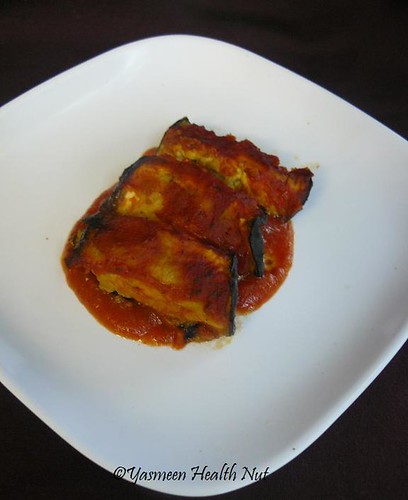
KURAT Al TAMIR - (Date Sesame Balls)
Sweet and nutty,these morsels make a nutritious dessert after a spicy meal.
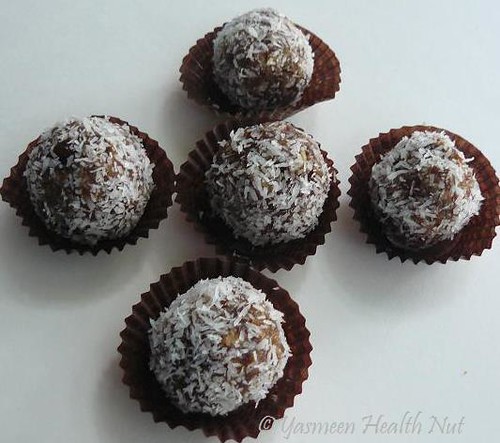
Recipe
Makes about 20 small balls.
Ingredients:
1 pound soft dates(I used Medjool)
1 cup walnuts
1/2 cup toasted sesame seeds or shred coconut
2 tablespoons tahini
½ teaspoon cardamom/cinnamon or both
Preparation:
Add dates, ½ cup sesame seeds, and tahini in the food processor. Pulse and add the walnuts and spices; pulse again. Take the mixture out and make small balls and roll them in toasted sesame or shredded coconut.
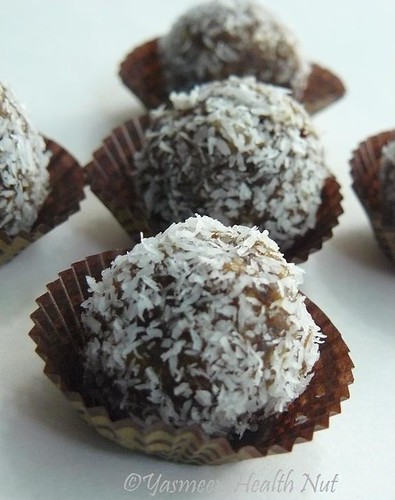
Cardamom Cookies - Shakar Lama
Buttery melt in the mouth delicious,the cardamom imparts sweet scent and exotic flavor to the rich cookies.
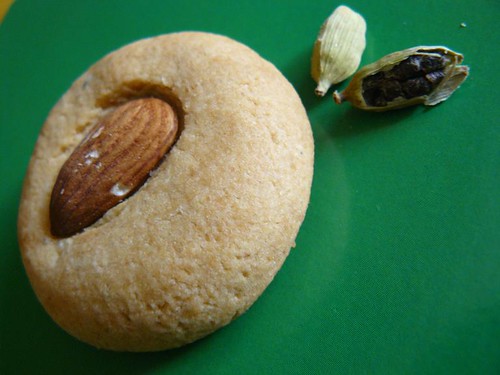
Recipe
Makes around 1 dozen
Ingredients:
3/4 cup whole wheat flour
1/2 cup all purpose flour
3 tablespoon Organic butter,softened not melted
1 tablespoon whole milk
3 tablespoon brown sugar or 2 tablespoon agave nectar
1 Organic egg yolk (optional)
1 teaspoon ground cardamom
1/4 teaspoon salt
few whole almonds
Preparation:
Beat the butter in a bowl for 3 minutes. Add sugar and beat the mixture until becomes light in color. Add flour, cardamom and salt gradually. Use your hand to mix the cookie dough. Take a small piece of dough the size of walnut. Shape the cookie and place and almond in the middle. Arrange on a tray with parchment paper or silicon pad. Bake for 20 minutes in 350 degree oven.

Health insurance employment in perspective
Ellen Andrews
Learn More About You
Here's things you can do:
- Build a skeleton, stretch some muscles and organise the organs in the interactive body.
- Discover how the body changes during puberty. And put your senses to the test in the senses challenge.
- Explore your memory
- Learn more about personality types
- Spot the fake smile.
- Take a personality test.
Acid Alkaline Balance
Read more>>
Sunday, August 30, 2009
Don’t take health advice from unhealthy people
She was obviously uncertain what to do. I told her to look at him and look at me and decide who was healthier.
I told her: “Don’t take health advice from unhealthy people.”
She laughed and said: “In that case it’s clear whose advice I should follow.”
Fruit is even better for you than previously thought
An international team of scientists has found that the polyphenol content of fruits has been underestimated.
Polyphenol content in fruits usually refers to extractable polyphenols, but a Spanish scientist working at the Institute of Food Research in Norwich analysed apple, peach and nectarine. She found that nonextractable polyphenol content is up to five times higher than extractable compounds. This work has been published in the Journal of Agricultural and Food Chemistry.
“These polyphenols need to be treated with acid to extract them from the cell walls of fruit in the lab,” said Sara Arranz from the Spanish Council for Scientific Research (CSIC) in Madrid. “If non-extractable polyphenols are not considered, the levels of beneficial polyphenols such as proanthocyanidins, ellagic acid and catechin are substantially underestimated.”
Dr Paul Kroon from IFR explains: “In the human body these compounds will be fermented by bacteria in the colon, creating metabolites that may be beneficial, for example with antioxidant activity.”
The Spanish research group, led by Professor Fulgencio Saura-Calixto, has been working to show that nonextractable polyphenols, which mostly escape analysis and are not usually considered in nutritional studies, are a major part of bioactive compounds in the diet.
“These polyphenols are major constituents of the human diet with important health properties. To consider them in nutritional and epidemiological research may be useful for a better understanding of the effects of plant foods in health,” says Professor Saura-Calixto.
The study was funded by a scholarship to Dr Arranz from the Spanish Ministry of Science and through the Institute Of Food Reaerch's core strategic grant from the Biotechnology and Biological Sciences Research Council.
Saturday, August 29, 2009
How to Get Rid of Pimples - Few Tips on How to Kill That Zit Safely!
When you squish your pimple it may become infected and it will create swelling and redness. Touching your face alone will help spread acne on your face so try not to do that. Here I have provided a few tips on how to get rid of your pimples for good.
Get rid your pimples tip 1.
The first step to getting rid of your pimples is not to pop it or hurt your skin in anyway. This will only make your skin red and inflamed making the appearance worsen.
This will also aid in the spreading of the pimple causing bacteria and the oils that give you pimples, in the end the worst thing you can do is pop that zit.
Get rid your pimples tip 2.
Use concealer this will hide your spot when you in the need for a quick appearance fix. Make up does not help you get rid of your pimples it's just there to hide it.
When use make up never ever forget to wash it off. If you don't wash your face you will create more pimple causing bacteria and oil. Most make up will clog your pours and lead to new pimple break outs, so always wash your make up off.
Get rid your pimples tip 3
To decrease the inflammation of the pimple try use an ice pack every 30 minutes on hold it firmly against it for at least 2 minutes. When applying the ice pack to the pimple it will bring down swelling, redness and practically will make your zit smaller.
Get rid your pimples tip 4
The best way to help get rid of your pimples is to cleanse your skin, at least twice a day. Try using a mild chemical free face wash or an acne face wash solution.
After a face wash you should apply an alcohol free skin toner to close up you clean pores. After applying skin toner add a light moisturising cream to avoid dry skin.
Try exfoliating you skin 3 times a week. Removing dead skin will help prevent your pores from getting blocked up. Try getting a gentle, natural, and water based exfoliation gel. You could also add table salt to you face wash but be very gentle when exfoliating your skin.
Well hope this helped you to get rid of your pimples. If you like this information and want to know the best practical cures for acne that are 100% free at http://acnesolution4u.blogspot.com please visit and thank you for reading.
Thursday, August 27, 2009
Mini Dobos Torta
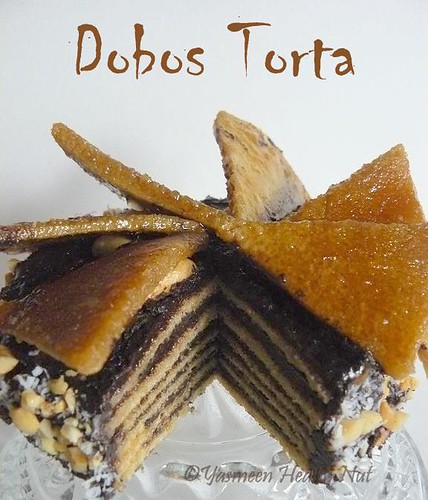
To do or Not to do was question for this month's daring baker challenge.The aftermath of moving was tiring ,Ramadan commencing ,but the luscious 5 layered sponge cake was too tempting to skip and with a special day to celebrate,the decadent cake was the best dessert I could treat myself with.I baked 2 mini dobos(with 6 layers each) ,skipped the eggs for the butter cream,used low fat cream cheese and 100% cocoa powder for the rich dark chocolate frosting.And the pretty pink mini dobos with rose syrup cream cheese frosting,reminded me of the sweet and innocent side of childhood.I'm a year older now and definitely a year nuttier :D.
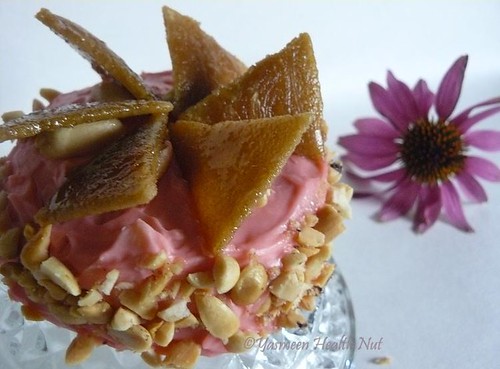
The August 2009 Daring Bakers' challenge was hosted by Angela of A Spoonful
of Sugar and Lorraine of Not Quite Nigella. They chose the spectacular Dobos
Torte based on a recipe from Rick Rodgers' cookbook Kaffeehaus: Exquisite
Desserts from the Classic Caffés of Vienna, Budapest, and Prague.
what is the Dobos Torta (or Torte)?
The Dobos Torta is a five-layer sponge cake, filled with a rich chocolate buttercream and topped with thin wedges of caramel. (You may come across recipes which have anywhere between six and 12 layers of cake; there are numerous family variations!) It was invented in 1885 by József C. Dobos, a Hungarian baker, and it rapidly became famous throughout Europe for both its extraordinary taste and its keeping properties. The recipe was a secret until Dobos retired in 1906 and gave the recipe to the Budapest Confectioners' and Gingerbread Makers' Chamber of Industry, providing that every member of the chamber can use it freely.
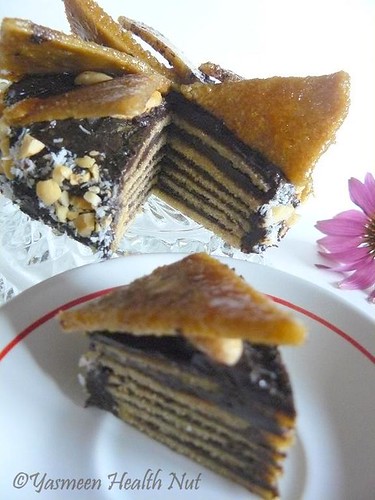
Equipment
* 2 baking sheets
* 4 inch round cookie cutter
* mixing bowls (1 medium, 1 large)
* a sieve
* a double boiler (a large saucepan plus a large heat-proof mixing bowl which fits snugly over the top of the pan)
* a small saucepan
* a whisk (you could use a balloon whisk for the entire cake, but an electric hand whisk or stand mixer will make life much easier)
* metal offset spatula
* sharp knife
* piping bag and tip, optional
Prep times
* Sponge layers 20 mins prep, 40 mins cooking total if baking each layer individually.
* Cream Cheese Frosting: 2 minutes
* Caramel layer: 10-15 minutes.
* Assembly of whole cake: 20 minutes
Sponge cake layers
* 4 large Organic eggs, separated, at room temperature
* 3/4 cup (162g) confectioner's (icing) sugar, divided
* 3/4 teaspoon (5ml) vanilla extract
* 3/4 cup all purpose flour
* 1 tablespoon corn starch
* pinch of salt
Chocolate Cream Cheese frosting
* 4 oz pack Low fat Cream cheese at room temperature
* 1/2 cup (100g) caster (ultrafine or superfine white) sugar
* 1/4 cup 100% cocoa powder(or use 2 tablespoon pink rose syrup for pink frosting)
* 2 tablespoon Organic butter,softened
Caramel topping
* 1 cup (200g) caster (superfine or ultrafine white) sugar
* 12 tablespoons (180 ml) water
* 8 teaspoons (40 ml) lemon juice
* 1 tablespoon neutral oil (e.g. grapeseed, rice bran, sunflower)
Finishing touches
* 12 whole hazelnuts, peeled and toasted
* ½ cup (50g) peeled and finely chopped hazelnuts

Directions for the sponge layers:
NB. The sponge layers can be prepared in advance and stored interleaved with parchment and well-wrapped in the fridge overnight.
1.Position the racks in the top and centre thirds of the oven and heat to 400F (200C).
2.Beat the egg yolks, 2/3 cup (81g) of the confectioner's (icing) sugar, and the vanilla in a medium bowl with a mixer on high speed until the mixture is thick, pale yellow and forms a thick ribbon when the beaters are lifted a few inches above the batter, about 3 minutes. (You can do this step with a balloon whisk if you don't have a mixer.)
3.In another bowl, using clean beaters, beat the egg whites until soft peaks form. Gradually beat in the remaining 2/3 cup (81g) of confectioner's (icing)sugar until the whites form stiff, shiny peaks. Using a large rubber spatula, stir about 1/4 of the beaten whites into the egg yolk mixture, then fold in the remainder, leaving a few wisps of white visible. Combine the flour and salt. Sift half the flour over the eggs, and fold in; repeat with the remaining flour.
4.Line the baking sheet with parchment paper, spread about half the batter in an even layer on one baking sheet. Bake on the top rack for 5 minutes, until the cake springs back when pressed gently in the centre and the edges are lightly browned. While this cake bakes, repeat the process on the other baking sheet, placing it on the centre rack. When the first cake is done, move the second cake to the top rack. Invert the first cake onto a flat surface and carefully peel off the paper. Slide the cake layer back onto the paper and let stand until cool. Rinse the baking sheet under cold running water to cool, and dry it before lining with another parchment. Continue with the remaining papers and batter to make a total of six layers. Completely cool the layers. Using an a 5 inch cookie cutter and cut each cake layer into a neat rounds.
Directions for the chocolate Cream Cheese Frosting:
Whip all the ingredients together in a large bowl,use a hand held mixer or a whisk to make a smooth frosting.
Directions for the caramel topping:
1.Choose the best-looking cake layer for the caramel top. To make the caramel topping: Line a jellyroll pan with parchment paper and butter the paper. Place the reserved cake layer on the paper. Score the cake into 12 equal wedges. Lightly oil a thin, sharp knife and an offset metal spatula.
2.Stir the sugar, water and lemon juice in a small saucepan. Bring to a boil over a medium heat, stirring often to dissolve the sugar. Once dissolved into a smooth syrup, turn the heat up to high and boil without stirring, swirling the pan by the handle occasionally and washing down any sugar crystals on the sides of the pan with a wet brush until the syrup has turned into an amber-coloured caramel.
3.The top layer is perhaps the hardest part of the whole cake so make sure you have a oiled, hot offset spatula ready. I also find it helps if the cake layer hasn't just been taken out of the refrigerator. I made mine ahead of time and the cake layer was cold and the toffee set very, very quickly—too quickly for me to spread it. Immediately pour all of the hot caramel over the cake layer. You will have some leftover most probably but more is better than less and you can always make nice toffee pattern using the extra to decorate. Using the offset spatula, quickly spread the caramel evenly to the edge of the cake layer. Let cool until beginning to set, about 30 seconds. Using the tip of the hot oiled knife (keep re-oiling this with a pastry brush between cutting), cut through the scored marks to divide the caramel layer into 12 equal wedges. Cool another minute or so, then use the edge of the knife to completely cut and separate the wedges using one firm slice movement (rather than rocking back and forth which may produce toffee strands). Cool completely.
Angela's note: I recommend cutting, rather than scoring, the cake layer into wedges before covering in caramel (reform them into a round). If you have an 8” silicon round form, then I highly recommend placing the wedges in that for easy removal later and it also ensures that the caramel stays on the cake layer. Once set, use a very sharp knife to separate the wedges.
Assembling the Dobos
1.Divide the cream cheese frosting into six equal parts.
2.Place a dab of chocolate frosting on the middle of each cake layer. Spread and repeat with 5 more cake layers. Spread the remaining icing on the sides of the cake.
3.Optional: press the finely chopped hazelnuts onto the sides of the cake.
4.Propping a hazelnut under each wedge so that it sits at an angle, arrange the wedges on top of the cake in a spoke pattern. If you have any leftover frosting, you can pipe rosettes under each hazelnut or a large rosette in the centre of the cake. Refrigerate the cake under a cake dome until the icing is set, about 2 hours. Let slices come to room temperature for the best possible flavour.
Storage
I (Angela) am quite happy to store this cake at room temperature under a glass dome, but your mileage may vary. If you do decide to chill it, then I would advise also using a glass dome if you have done. I should also note that the cake will cut more cleanly when chilled.
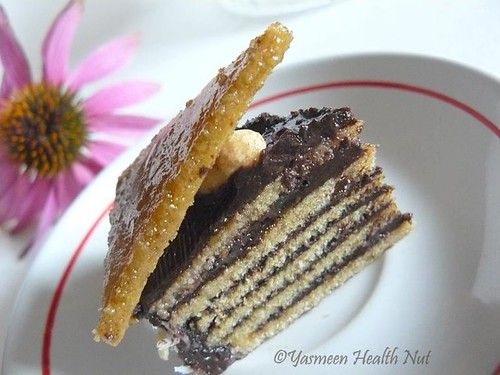
A mini slice for Angela and lorraine for the delicious challenge.Check out other daring bakers dobos.
CT family premiums fifth highest in nation
Read the report and you’ll be able to ace the September CT Health Policy Web Quiz.
Ellen Andrews
Wednesday, August 26, 2009
Rationing Health Care
Rationing Health Care
Omega-3 and fibre prevent risk of non-Hodgkin's lymphoma
* Just over 1,000 people completed a dietary questionnaire in a study looking at the association between certain foods and the risk of developing non-Hodgkin’s lymphoma.
* Dietary fibre and fish oils including omega-3 greatly reduced the risk of developing non-Hodgkin’s lymphoma.
* Other foods containing beta-carotene and alpha-tocopherol (vitamin E) were also beneficial, although calcium and retinol were found to slightly increase the risk.
Shaun’s comment: Non-Hodgkin's lymphomas are a group of diseases which are cancers of the white blood cells and are different to another type, which is called Hodgkin's disease. People who get the disease usually first notice painless swellings in areas where there are lots of lymph nodes, such as the armpit or groin. Among the major findings of this case-control study was the association of a reduced risk of this cancer in those who included omega-3 fatty acid and fibre in the diet.
Study reference:
http://dx.doi.org/10.1093/aje/kwj330
Tuesday, August 25, 2009
Pineapple Ginger Chutney

Except for the peeling part I totally enjoy pineapples.The last one we bought was so fully ripened and had to be used in a day.Why not make a tongue tickling chutney for a change?.The spice from Ginger and chili peppers balances the sweetness from the fruit,and lime juice adds a nice tang to sweet and spicy concoction.The experiment turned out to be a toothsome condiment,the Vitamin loaded chutney is relishing with chips and crackers,spread on sandwiches or mixed with rice.
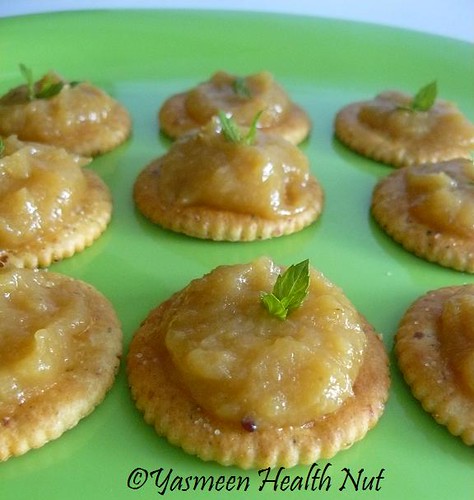
Recipe
Ingredients
1/2 a fresh pineapple,peeled and cubed
1 inch piece fresh ginger root,minced
1 hot or medium hot chili peppers,seeded and chopped(I used habanero)
1 cinnamon stick
2 tablespoon fresh lime juice
2 tablespoon sugar(optional,I didn't use any)
Pinch of salt

Method

Combine all ingredients in a saucepan ,avoid reactive metallic containers like aluminum or cast iron,preferably use stainless steel.Bring the contents to a slow boil,simmer until completely soft and mushy for 25-30 minutes,stir occasionally.check the seasonings, add more lemon juice if needed.Remove the cinnamon stick.For a more smooth chutney ,grind to a finer paste,then return to the saucepan.Mix a teaspoon of cornstarch with equal quantity of water.Stir in the chutney and simmer another 5-10 minutes.Cool and store in an sterilized air tight jar for over 2-3 months.
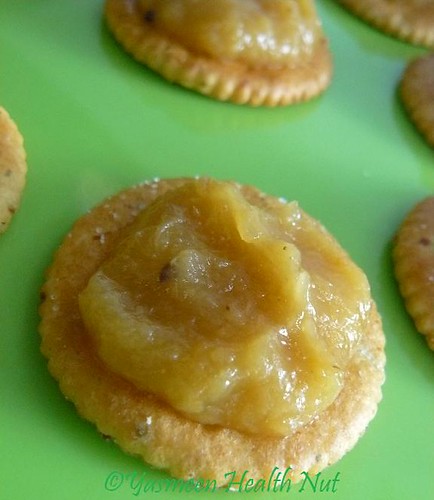
The chutney is off to Weekend wokking,the ingredients of the month is Ginger and the host is MomGateway
Undecipherable health insurance documents
Here is an example from the plan document’s “Exclusions and Limitations” section. This is exclusion number 2 out of 75: “Benefits may be reduced; or denied if subject to the Managed Benefits Managed Care Guidelines. Any reduced or denied benefits paid by the Member do not count toward any applicable Cost Share Maximums shown in the Schedule of Benefits.” I think I figured out what it means but I had to read it several times.
A recent New York Times op-ed piece discusses this issue and gives the example of a man whose chemotherapy was denied by his insurance company. He couldn’t understand his insurance policy and why he was denied. When the Rhode Island Health Insurance Commissioner’s Office called the insurance company on his behalf, they were told that the claim was denied because they were still trying to figure out if the medical services were covered. They didn’t understand the policy either.
Starting next year, Rhode Island will require that all insurance policies are written at an eighth-grade level. The US House of Representative’s health reform bill has a proposal that some parts of insurance policies should be written in “plain language.” There is other proposed legislation at the federal level that would require “uniform and simplified coverage information.” Insurance policies must be understandable to be useful.
Jen Ramirez
Monday, August 24, 2009
How to diagnose flu
When I was a student nurse back in the sensible Seventies, we were taught a simple diagnosis for those with influenza. If there is a $10 note on the floor and the patient can get out of bed to pick it up, then he does not have flu, simply a common cold.
Similarly, anyone collecting his own Tamiflu from the pharmacy should be sent away empty-handed.
Dr. Stephan
Ataxin-7 Conserved Motifs Determine the Severity of the Neurodegenerative Disorder Spinocerebellar Ataxia Type 7 in Transgenic Mice and Influence Lifespan in Yeast
Spinocerebellar ataxia type 7 (SCA7) is an autosomal dominant, progressive neurodegenerative disorder whose characteristic features are cerebellar ataxia, dysarthria, and retinal cone-rod dystrophy culminating in blindness. SCA7 is caused by an abnormally long glutamine-coding CAG repeat in the SCA7 gene, which encodes the protein Ataxin-7.
Ataxin-7 contains several conserved motifs that may influence the toxicity of the glutamine tract. Among these are three conserved regions (conserved block I – III), two caspase-7 cleavage sites, a nuclear export signal and two monopartite nuclear localization signals (NLS). Previous investigations have shown that the caspase-7 cleavage site D266 is required for the full toxicity of the Ataxin-7 protein in cell culture. We generated SCA7 transgenic mice expressing a 92 CAG version of the human SCA7 cDNA, with and without a D266N mutation. Mice carrying the D266N mutation were protected from SCA7-like neurodegeneration, behavioral signs and shortened lifespan.
To further characterize the role of conserved motifs in SCA7 pathology, we generated SCA7 transgenic mice carrying point mutations in both C-terminal NLSs (KKRK -> KAAK). Previous work has shown that nuclear localization is an important step in the pathology of CAG repeat disorders. We observed that mice lacking C-terminal NLS activity were substantially protected from degeneration of the retina and cerebellum, SCA7-like behavioral signs and shortened lifespan.
Age is the primary risk factor for neurodegenerative disease. Even in the absence of overt disease, the aging brain shows histopathological and molecular changes reminiscent of neurodegeneration. To explore the link between neurodegenerative disease and aging, we have examined the replicative lifespan of Saccharomyces cerevisiae missing the SCA7 ortholog, SGF73. This strain exhibits an unusually long lifespan, which is dependent on the function of the NAD+-dependent deacetylase SIR2. We present evidence that the extended lifespan of the SGF73 null strain is due to the influence of Sgf73 on the activity of Sir2 and the histone deubiquitinase Ubp8. Furthermore, we show that the level of ubiquitinated H2B is elevated in an SCA7 transgenic mouse line, indicating that an alteration in Ubp8 activity may play a role in SCA7 pathology and that aging and neurodegeneration may share a common mechanism.
Dr. Stephan
Ataxin-7 Conserved Motifs Determine the Severity of the Neurodegenerative Disorder Spinocerebellar Ataxia Type 7 in Transgenic Mice and Influence Lifespan in Yeast
Spinocerebellar ataxia type 7 (SCA7) is an autosomal dominant, progressive neurodegenerative disorder whose characteristic features are cerebellar ataxia, dysarthria, and retinal cone-rod dystrophy culminating in blindness. SCA7 is caused by an abnormally long glutamine-coding CAG repeat in the SCA7 gene, which encodes the protein Ataxin-7.
Ataxin-7 contains several conserved motifs that may influence the toxicity of the glutamine tract. Among these are three conserved regions (conserved block I – III), two caspase-7 cleavage sites, a nuclear export signal and two monopartite nuclear localization signals (NLS). Previous investigations have shown that the caspase-7 cleavage site D266 is required for the full toxicity of the Ataxin-7 protein in cell culture. We generated SCA7 transgenic mice expressing a 92 CAG version of the human SCA7 cDNA, with and without a D266N mutation. Mice carrying the D266N mutation were protected from SCA7-like neurodegeneration, behavioral signs and shortened lifespan.
To further characterize the role of conserved motifs in SCA7 pathology, we generated SCA7 transgenic mice carrying point mutations in both C-terminal NLSs (KKRK -> KAAK). Previous work has shown that nuclear localization is an important step in the pathology of CAG repeat disorders. We observed that mice lacking C-terminal NLS activity were substantially protected from degeneration of the retina and cerebellum, SCA7-like behavioral signs and shortened lifespan.
Age is the primary risk factor for neurodegenerative disease. Even in the absence of overt disease, the aging brain shows histopathological and molecular changes reminiscent of neurodegeneration. To explore the link between neurodegenerative disease and aging, we have examined the replicative lifespan of Saccharomyces cerevisiae missing the SCA7 ortholog, SGF73. This strain exhibits an unusually long lifespan, which is dependent on the function of the NAD+-dependent deacetylase SIR2. We present evidence that the extended lifespan of the SGF73 null strain is due to the influence of Sgf73 on the activity of Sir2 and the histone deubiquitinase Ubp8. Furthermore, we show that the level of ubiquitinated H2B is elevated in an SCA7 transgenic mouse line, indicating that an alteration in Ubp8 activity may play a role in SCA7 pathology and that aging and neurodegeneration may share a common mechanism.
Dr. Stephan
Ataxin-7 Conserved Motifs Determine the Severity of the Neurodegenerative Disorder Spinocerebellar Ataxia Type 7 in Transgenic Mice and Influence Lifespan in Yeast
Spinocerebellar ataxia type 7 (SCA7) is an autosomal dominant, progressive neurodegenerative disorder whose characteristic features are cerebellar ataxia, dysarthria, and retinal cone-rod dystrophy culminating in blindness. SCA7 is caused by an abnormally long glutamine-coding CAG repeat in the SCA7 gene, which encodes the protein Ataxin-7.
Ataxin-7 contains several conserved motifs that may influence the toxicity of the glutamine tract. Among these are three conserved regions (conserved block I – III), two caspase-7 cleavage sites, a nuclear export signal and two monopartite nuclear localization signals (NLS). Previous investigations have shown that the caspase-7 cleavage site D266 is required for the full toxicity of the Ataxin-7 protein in cell culture. We generated SCA7 transgenic mice expressing a 92 CAG version of the human SCA7 cDNA, with and without a D266N mutation. Mice carrying the D266N mutation were protected from SCA7-like neurodegeneration, behavioral signs and shortened lifespan.
To further characterize the role of conserved motifs in SCA7 pathology, we generated SCA7 transgenic mice carrying point mutations in both C-terminal NLSs (KKRK -> KAAK). Previous work has shown that nuclear localization is an important step in the pathology of CAG repeat disorders. We observed that mice lacking C-terminal NLS activity were substantially protected from degeneration of the retina and cerebellum, SCA7-like behavioral signs and shortened lifespan.
Age is the primary risk factor for neurodegenerative disease. Even in the absence of overt disease, the aging brain shows histopathological and molecular changes reminiscent of neurodegeneration. To explore the link between neurodegenerative disease and aging, we have examined the replicative lifespan of Saccharomyces cerevisiae missing the SCA7 ortholog, SGF73. This strain exhibits an unusually long lifespan, which is dependent on the function of the NAD+-dependent deacetylase SIR2. We present evidence that the extended lifespan of the SGF73 null strain is due to the influence of Sgf73 on the activity of Sir2 and the histone deubiquitinase Ubp8. Furthermore, we show that the level of ubiquitinated H2B is elevated in an SCA7 transgenic mouse line, indicating that an alteration in Ubp8 activity may play a role in SCA7 pathology and that aging and neurodegeneration may share a common mechanism.
Dr. Stephan
Ataxin-7 Conserved Motifs Determine the Severity of the Neurodegenerative Disorder Spinocerebellar Ataxia Type 7 in Transgenic Mice and Influence Lifespan in Yeast
Spinocerebellar ataxia type 7 (SCA7) is an autosomal dominant, progressive neurodegenerative disorder whose characteristic features are cerebellar ataxia, dysarthria, and retinal cone-rod dystrophy culminating in blindness. SCA7 is caused by an abnormally long glutamine-coding CAG repeat in the SCA7 gene, which encodes the protein Ataxin-7.
Ataxin-7 contains several conserved motifs that may influence the toxicity of the glutamine tract. Among these are three conserved regions (conserved block I – III), two caspase-7 cleavage sites, a nuclear export signal and two monopartite nuclear localization signals (NLS). Previous investigations have shown that the caspase-7 cleavage site D266 is required for the full toxicity of the Ataxin-7 protein in cell culture. We generated SCA7 transgenic mice expressing a 92 CAG version of the human SCA7 cDNA, with and without a D266N mutation. Mice carrying the D266N mutation were protected from SCA7-like neurodegeneration, behavioral signs and shortened lifespan.
To further characterize the role of conserved motifs in SCA7 pathology, we generated SCA7 transgenic mice carrying point mutations in both C-terminal NLSs (KKRK -> KAAK). Previous work has shown that nuclear localization is an important step in the pathology of CAG repeat disorders. We observed that mice lacking C-terminal NLS activity were substantially protected from degeneration of the retina and cerebellum, SCA7-like behavioral signs and shortened lifespan.
Age is the primary risk factor for neurodegenerative disease. Even in the absence of overt disease, the aging brain shows histopathological and molecular changes reminiscent of neurodegeneration. To explore the link between neurodegenerative disease and aging, we have examined the replicative lifespan of Saccharomyces cerevisiae missing the SCA7 ortholog, SGF73. This strain exhibits an unusually long lifespan, which is dependent on the function of the NAD+-dependent deacetylase SIR2. We present evidence that the extended lifespan of the SGF73 null strain is due to the influence of Sgf73 on the activity of Sir2 and the histone deubiquitinase Ubp8. Furthermore, we show that the level of ubiquitinated H2B is elevated in an SCA7 transgenic mouse line, indicating that an alteration in Ubp8 activity may play a role in SCA7 pathology and that aging and neurodegeneration may share a common mechanism.
Chobani Greek Yogurt.Eggless Cherry Muffins and Pomegranate Smoothie
- AgroFarma,Inc.
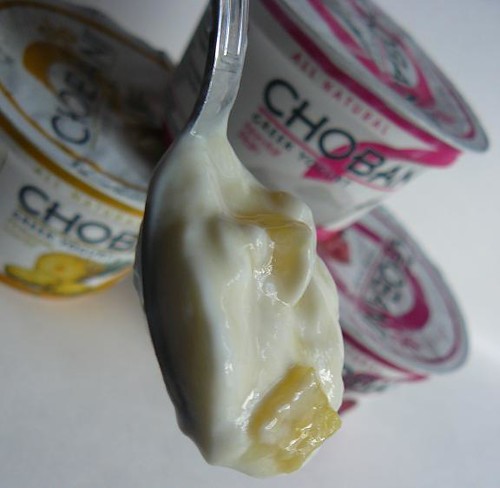
AgroFarma, Inc.,a NY based dairy product manufacturer founded by Hamdi Ulukaya, recently introduced a delicious new product called Chobahi Greek Yogurt.Creating true Greek yogurt is an art. It uses a centuries old technique that originated in Europe and includes taking something away and not adding anything. In fact, Greek yogurt is not heavily processed or enhanced with preservatives or sweeteners. A unique straining process where the whey is removed results in great tasting yogurt that is pure, clean, and simple, and has a rich, thick,and creamy texture.
AgroFarma, Inc., located in the rolling hills of Upstate NY, produces Chobani Greek Yogurt.There,a team of yogurt makers with more than 40 years of experience has made it its mission to produce the highest quality, all natural Greek yogurts.

Reason to treat oneself with Chobani
Protein
Derived from the Greek word chopani meaning “shepherd”,Chobani Greek Yogurt offers more than twice the amount of protein found in other major U.S.brands.One serving of Chobani Greek Yogurt can deliver up to 34 percent of an adult's daily protein requirement.Chobani is a smart choice for the South beach ,Atkins dieters or those on low or no meat diet.
Calcium
Chobani is an excellent source of calcium,each cup completes 20 percent of an adult’s recommended daily needs.Calcium rich yogurts if eaten regularly, may reduce the risk of osteoporosis, the thinning and loss of bone mass that affects 25 million Americans as they age.And can also reduce the risk of colon cancer.
Probiotics
Chobani has 5 live and active cultures(Lactobacillus bulgaricus and Streptococcus thermophilus, as well as Lactobacillus acidophilus, Bifidus, and L Casei.) that boosts immunity by regulating lymphocytes, as well as antibodies within the body. Studies have also shown that probiotics help improve digestion, combat lactose intolerance and constipation, and promote the growth of healthy bacteria in the colon, reducing carcinogens.
Organic
The company uses organic farming practices to preserve the environment with a focus on producing high-quality and all-natural yogurts. All of the products are made with milk that contains no artificial hormones,preservatives and added sweeteners and the manufacturing facility is HACCP certified to ensure safety and quality,thus completely suitable for all ages.
Part of Mediterranean Diet
Mediterranean diet emphasizes an abundance of food from plant sources, including vegetables, fruits, and whole grains. It also directs people to eat minimally processed foods, while increasing their intake of low/nonfat,dairy products, to maximize health benefits. In addition, the Mediterranean diet calls for an emphasis on lean sources of protein, and limiting the consumption of red meat. Research has shown that the people of the Mediterranean region enjoy longer and healthier lives with fewer incidences of chronic disease
Flavors
With 8 different flavors including - Blueberry,Peach,Pineapple,Strawberry,Honey,Pomegranate,
vanilla and plain,all available in Non Fat, 2% Fat and 10% Fat, Chobani has a yogurt for everyone.
Thick ,rich and fruity ,all the fruit flavored varieties with bits of real fruits are as good as desserts themselves.One can also use them in baking or whipping up smoothies.The plain variety is also great for baking and for enriching and enhance the texture of dips and salads dressings.
Plain Non-fat Chobani with crunchy granola and fruit ~ Perfect start of the day
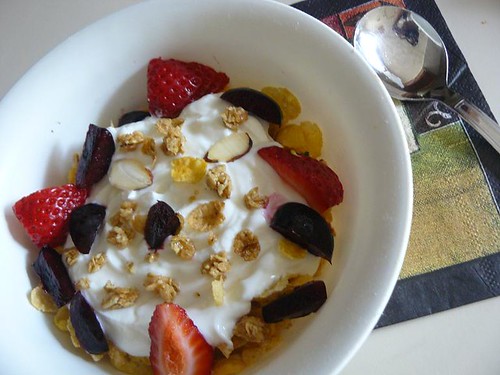
Plain Non-fat Chobani in Eggless Cherry Muffins ~ Delicious!
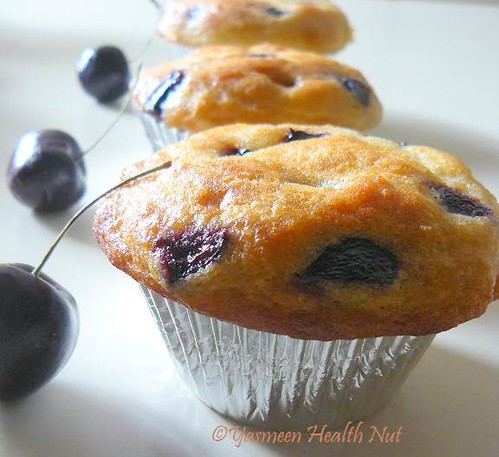
Recipe
Ingredients
1 cup whole wheat flour
3/4 cup all purpose flour
1 cup non-fat plain Chobani Greek Yogurt
2 tablespoon low fat organic milk
1 teaspoon baking powder
1/4 teaspoon salt
1/4 cup honey or 1/2 cup brown sugar or 2 tablespoon Agave nectar
2 tablespoon Olive oil or vegetable oil
1 teaspoon pure vanilla extract
1/2 cup cherries (fresh or dried ,I used fresh),chopped
Method
preheat oven to 400 F.
Line the muffin tray with parchment cups.
In a mixing bowl, combine flour, baking powder, and salt. Set aside. In another bowl combine the yogurt ,milk,with honey, oil and vanilla extract. Mix wet mixture with the dry ingredients . Stir in the cherries until combined.
Spoon batter into each prepared muffin cup. Bake for about 20 minutes, or until golden brown.Serve warm.
Makes about 6 medium muffins
Pomegranate Chobani Smoothie ~ Luscious!
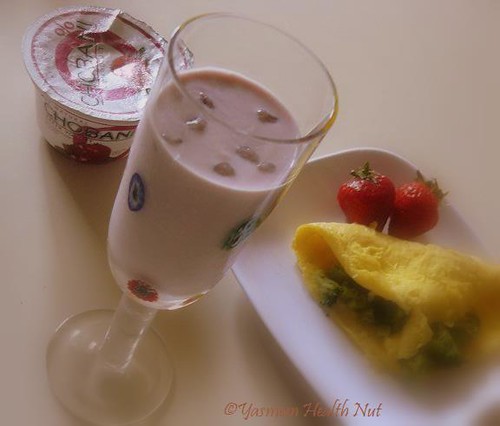
After tasting the samples of Pineapple and pomegranate,We couldn't wait to try the other flavors.By happy chance we found a variety pack at the Costco.Chobani is also available in these other stores.
Does expanding health insurance improve health?
Ellen Andrews
Sunday, August 23, 2009
Evidence for...Folic acid for heart disease prevention
Yilmaz H et al.
Acta Cardiol. 2007;62:579-85.
In patients with hyperhomocysteinaemic coronary artery disease, folic acid 5 mg/day for 8 weeks lowered plasma homocysteine levels and improved endothelial function.
Global improvement of vascular function and redox state with low-dose folic acid: implications for folate therapy in patients with coronary artery disease.
Shirodaria C et al.
Circulation. 2007;115:2262-70.
In patients scheduled to undergo coronary artery bypass grafting, 7 weeks' treatment with low-dose folic acid treatment (400 microg/day), comparable to daily intake and dietary fortification, improved vascular function through effects on endothelial nitric oxide synthase and vascular oxidative stress. High-dose folic acid treatment (5 mg/day) provided no additional benefit.
Dietary intake of folate equivalents and risk of myocardial infarction in the European Prospective Investigation into Cancer and Nutrition (EPIC)--Potsdam study.
Drogan D et al.
Public Health Nutr. 2006;9:465-71.
In this large German study population (22,245 apparently healthy non-users of vitamin supplements aged 35-64 years), higher intake of dietary folate equivalents was associated with decreased risk of myocardial infarction.
Saturday, August 22, 2009
Friday, August 21, 2009
Homeopathy not a cure, says WHO
In a letter to the WHO in June, medics from the UK and Africa said: "We are calling on the WHO to condemn the promotion of homeopathy for treating TB, infant diarrhoea, influenza, malaria and HIV.
"Homeopathy does not protect people from, or treat, these diseases.
"Those of us working with the most rural and impoverished people of the world already struggle to deliver the medical help that is needed.
"When homeopathy stands in place of effective treatment, lives are lost."
Dr Nick Beeching, a specialist in infectious diseases at the Royal Liverpool University Hospital, said: "Infections such as malaria, HIV and tuberculosis all have a high mortality rate but can usually be controlled or cured by a variety of proven treatments, for which there is ample experience and scientific trial data.
"There is no objective evidence that homeopathy has any effect on these infections, and I think it is irresponsible for a healthcare worker to promote the use of homeopathy in place of proven treatment for any life-threatening illness."
Read more here...
Ramadan Kareem!:Joy from Fasting to Feasting(Season II)

RAMADAN KAREEM to all the viewers fasting this blessed month of Ramadan.
Celebrate the spirit of Ramadan ,join me and my good friend Lubna at Kitchen Flavours for Season II of Joy from Fasting to Feasting.Share your experiences ,hopes ,aspirations and perspectives this Ramadan besides the good food prepared for the Suhoor and Iftar meals.Find more details here at Lubna's announcement.

Thanks Lubna for your efforts.Take a peek in to the previous Ramadan entries .
Lovely Ladies who have joining in the Season II are :
Aysha - Life Today
Faiza - Faiza Ali's Kitchen
Fitri - Rumah Manis
Lubna - Yummy Food
MamaFami - Mamafami's Spice and Splendour
Mona - Zaiqa
Muneeba - An Edible Symphony
Noor - Ya Salam Cooking
Retno - Kedai Hamburg
Shab - Shab's Cuisine
Shaista - MixCalculations
Shifa - Sugar And Spice
Umbelbanat - أم البنات
Health NutZainab and Meedo - Arabic Bites
Test your knowledge of national health care reform
Ellen Andrews
Thursday, August 20, 2009
New 'Biofactories' Produce Endangered Devil's Claw
delivered the report, pointed out that for thousands of years, native populations in Southern Africa have used the Devil's claw as a remedy for a huge number of ailments, including fever, diarrhea and blood diseases. Today, there are dozens of medicinal and herbal products around the world that are based on chemicals derived from the Devil's claw.
"In Germany, 57 pharmaceutical products based on Devil's claw, marketed by 46 different companies, have cumulative sales volumes alone worth more than $40 million." Georgiev noted. In the United States, Devil's claw extracts are in phase II clinical trials for the treatment of hip and knee arthritis. Other promising uses are not far behind. But while the demand for these beneficial compounds is increasing, the supply of natural Devil's claw is dwindling.
Read more here...
Lulur Scrub Badan (Body Scrub)
 Lulur Boreh (Ginger)
Lulur Boreh (Ginger)Mengandung rempah-rempah yang dapat membuang racun - racun dari dalam tubuh, menyembuhkan masuk angin, nyeri otot, sehingga peredaran darah menjadi lancar, menyehatkan kulit dan mengatasi bakteri pada kulit
Lulur Melati (Jasmine)
Menjadikan kulit putih, bersih halus, serta membuat kulit menjadi lebih halus dan lembut.
Lulur Bengkoang
Mengangkat kulit mati, komposisi mineral bengkuang mengandung zat pembersih yang sempurna untuk kulit kusam, serta dapat memutihkan kulit secara alami. Kulit nampak bersih, sehat dan segar.
Lulur Susu (Milk)
menghaluskan dan meremajakan kulit.Susu dikenal sebagai substansi yang dapat mempertahankan kulit agar tetap putih berseri, lembut dan kenyal.
Lulur strawberry
Buah yang satu ini banyak mengandung asam salisilat (salah satu jenis asam beta-hidroksi) yang membantu mengencangkan kulit), serta vitamin B, C, E, dan K. Lulur strawberry selain untuk mengencangkan kulit juga menyehatkan dan meremajakan kulit. Cocok digunakan hampir oleh semua jenis kulit. Wewangiannya yang khas menjadikan lulur ini cocok untuk terapi relaksasi.
Lulur Kopi (Coffe)
Menghaluskan kulit, membuat kulit lebih cerah. Menghilangkan lelah pada kulit, memperbaiki sirkulasi O2 dan peredaran darah tepi.
Lulur Coklat
Menjadikan kulit halus dan lembut, bagus untuk kulit yang sering diruangan AC.
Lulur Lavender
Menghaluskan kulit, memberikan nutrisi pada kulit, keharumannya dapat menenangkan pikiran (relaksasi) dan anti nyamuk.
Lulur Mawar (Rose)
Menghaluskan kulit, memberikan nutrisi pada kulit, dan menjadikan kulit halus.
Lulur Avocado
Melembabkan kulit, mencerahkan kulit dan meratakan warna kulit.
Lulur Rumput Laut (Seaweed)
Memberikan nutrisi pada kulit, menghaluskan kulit dan menghilangkan bau badan.
Lulur Lemonade
Untuk detox dan body slimming, mengandung vit E berfungsi untuk menetralkan kulit berminyak, membantu mengangkat sel-sel kulit mati,
menghancurkan lemak dibawah kulit, dan mencegah keriput pada kulit.
Lulur Lumpur (Volcano)
Mengencangkan & menghilangkan selulit kulit, mengangkat kulit mati dan kotoran, menjadikan kulit halus, lembut dan bersih.
Lulur GreenTea
Mengandung sari greentea dan herbal lainnya sebagai penangkal radikal bebas, mendinginkan kulit serta membuat kulit menjadi lebih halus dan lembut, dapat mengangkat sel kulit mati, menghaluskan badan dengan aroma greentea yang menyegarkan.
Lulur Kuning
Menjadikan kulit halus dan lembut, menjadikan kulit kuning langsat dan bersih bercahaya, meratakan & mencerahkan warna kulit, merangsang pertumbuhan sel kulit baru.
Phone : sms (08386825258)
E-mail : mahkotadewarosella@yahoo.com
http://mahkotadewa.net/
The Cause of Pimples and How to Treat Them
Usually acne occurs in a certain time frame, usually around the time of adolescence (of course there are exceptions to the rules), while pimples, with the right triggers, can occur anytime and that is the difference between the two.
The main cause of pimples is very often a combination of bacteria being there and dead skin cells, which accumulate in the pores. Bacteria is actually living on our skin and the problem starts when the bacteria finds its way into the pores and they get infected. The infection can show up through red lumps or bumps and it doesn't necessarily stops there because these could produce pus. Another cause of pimples can be poor hygiene and an accumulation of dead skin cells due to sebum. If you don't clean your skin properly it can cause pimples because it allows an accumulation of sebum, dead skin cells and dirt. Alternatively, there needs to be a balance, because if you wash your skin too much it can cause more production of sebum and that can aggravate pimples. If you wash your skin twice a day it will be enough to control the production of sebum. It is quite important to avoid touching your face because that can also help to reduce your skin to be exposed to dirt and dust.
If your immune system goes through any changes, because your defenses are lower, which will make you more susceptible to an infection, it could be a cause of pimples. And then let's not forget, here's the word 'STRESS' or hormonal changes those can be huge factors for the cause of pimples. Your health and wellness can actually be hampered through stress. If you want stress relieve you probably need some determination because this is certainly not easy. But it can be done. Consider taking up meditation.
In particular if you are a women you will notice that you usually get some pimples just before you get your period and that's were the hormonal change comes in, which is the cause of pimples. Those pimples usually disappear in a few days and this cause of pimples is easy to manage. It's still annoying and if you are affected by those kind of pimples try and keep you skin extra clean and sebum free just before your period.
These are the most common causes of pimples and their treatments are the easiest.
There are a lot of expensive products out there and a lot of them don't even work. For years I suffered from acne and believe me I tried lots of different products, cheap and expensive ones until I finally found a solution. It helped me to get rid of my acne in days. Don't waste anymore time and money on useless products.
To find out more click: http://www.treatyouracne.com
Please feel free to republish this article on your website, or distribute it to your friends or clients, as long as you leave the resource box intact.
Hospital community benefits reports out
Ellen Andrews
Wednesday, August 19, 2009
FiveFingers in the Alpine Lakes Wilderness
 I recently bought a pair of Vibram FiveFingers Sprint (pictured). They're minimal, lightweight shoes with "toes". They're designed to mimic barefoot walking as closely as possible, while protecting the feet from punctures and abrasion. The soles are thin, flexible and offer no padding whatsoever.
I recently bought a pair of Vibram FiveFingers Sprint (pictured). They're minimal, lightweight shoes with "toes". They're designed to mimic barefoot walking as closely as possible, while protecting the feet from punctures and abrasion. The soles are thin, flexible and offer no padding whatsoever.I've always been a barefoot walker, because our feet evolved to be nude (or close to it). Besides feeling amazing, walking barefoot allows the body to express proper biomechanics. My feet have become tougher over time, but I still can't handle a rough trail barefoot.
When I first put the FiveFingers on, my initial thought was "these don't feel as much like being barefoot as I wish they did". Simply having something between your skin and the ground makes your feet much less sensitive. But I got used to them quickly, eventually using them for my parkour training.
I had a few converstions with my parkour instructor Rafe Kelley, during which I realized I had to re-teach myself how to walk and run correctly. Rafe is well-versed in natural human movement due to his background in MovNat, gymnastics, martial arts, strength training, parkour and anthropology. Modern shoes allow us to walk and run in a way that our bodies did not evolve to tolerate. The padding in shoes allows us to take large steps, in which we overshoot our center of gravity and contact the ground in a jarring manner. It also allows us to strike with our heels when we run, which is not comfortable when you're barefoot.
I took the FiveFingers on a 13-mile hike in the Alpine
 Lakes wilderness with a few friends last weekend. The Pacific Northwest has to be one of the most beautiful places in the world. I was expecting to use the shoes for a few miles and then swap them for my lightweight hiking shoes (Inov8 Flyroc trail runners). The beginning of the trail was really rocky and I thought I was going to have to take them off in the first few hundred yards. Surprisingly, my feet adapted, and although the trail stayed rocky, it became fairly comfortable by the time we had walked a mile.
Lakes wilderness with a few friends last weekend. The Pacific Northwest has to be one of the most beautiful places in the world. I was expecting to use the shoes for a few miles and then swap them for my lightweight hiking shoes (Inov8 Flyroc trail runners). The beginning of the trail was really rocky and I thought I was going to have to take them off in the first few hundred yards. Surprisingly, my feet adapted, and although the trail stayed rocky, it became fairly comfortable by the time we had walked a mile.I found myself thinking about Rafe's advice, and taking smaller steps that strike closer to my center of gravity. Although my strides were shorter, I had no trouble keeping up, and in fact going up the hills was remarkably easy. We gained 3,000 feet of elevation but I never got winded. I had to pay close attention to foot placement, which kept me from looking around much but was actually kind of fun.
After a few miles, I switched to my hiking shoes, with the idea that I should switch before my feet really started to hurt, rather than after. I immediately noticed that going up hills was harder, especially on my calves. My feet felt more cumbe
 rsome as well.
rsome as well.Here's me foraging for mushrooms on the trail. This is Laetiporus sulphureus, also known as "chicken of the woods". It's widely eaten in this area. However, my mushroom guide All That the Rain Primises, and More, had this to say about it:
"If you eat and enjoy this moushroom, always cook it thoroughly and do not serve it to lawyers, landlords, employers, policemen, pit bull owners, or others whose good will you cherish!"
I didn't take my chances. If you're going to pick wild mushrooms, make sure you know what you're doing and carry a regional identification guide. "I recognize them from China/Russia/Europe" kills several people a year in the Pacific Northwest. If you're experienced, this area is a mushroom bonanza. I can't set foot outside without stepping on a king bolete (porcini, cep) in the fall.
I ended up switching back to the FiveFingers for the majority of the hike, about 9 miles of it. The soles of my feet were a bit sore by the end (due to stepping on sharp rocks for miles), but my joints and muscles felt remarkably good! I had no joint pain or muscle tightness. I also felt pretty energetic. This was a big surprise, since I haven't done much hiking this year. The next day, my calves were sore, but that was it.
All in all, I really like the FiveFingers. I can wear them in places that require shoes, yet remain nearly barefoot. One potential drawback is the price-to-durability ratio. They cost me $80 and I don't expect them to last a year. That being said, I'm putting a brutal beating on them. Parkour training destroys shoes. The rubber seems to be excellent quality (which you'd expect from Vibram), but it's thin and it has cuts in it for flexibility and grip, which will lower its lifespan. The upper is simply a piece of stretchy fabric that tears easily. I'm willing to deal with the durability issues because the advantages outweigh them [update- several FiveFingers wearers have commented that they actually last a surprisingly long time. See comments].
FiveFingers in the Alpine Lakes Wilderness
 I recently bought a pair of Vibram FiveFingers Sprint (pictured). They're minimal, lightweight shoes with "toes". They're designed to mimic barefoot walking as closely as possible, while protecting the feet from punctures and abrasion. The soles are thin, flexible and offer no padding whatsoever.
I recently bought a pair of Vibram FiveFingers Sprint (pictured). They're minimal, lightweight shoes with "toes". They're designed to mimic barefoot walking as closely as possible, while protecting the feet from punctures and abrasion. The soles are thin, flexible and offer no padding whatsoever.I've always been a barefoot walker, because our feet evolved to be nude (or close to it). Besides feeling amazing, walking barefoot allows the body to express proper biomechanics. My feet have become tougher over time, but I still can't handle a rough trail barefoot.
When I first put the FiveFingers on, my initial thought was "these don't feel as much like being barefoot as I wish they did". Simply having something between your skin and the ground makes your feet much less sensitive. But I got used to them quickly, eventually using them for my parkour training.
I had a few converstions with my parkour instructor Rafe Kelley, during which I realized I had to re-teach myself how to walk and run correctly. Rafe is well-versed in natural human movement due to his background in MovNat, gymnastics, martial arts, strength training, parkour and anthropology. Modern shoes allow us to walk and run in a way that our bodies did not evolve to tolerate. The padding in shoes allows us to take large steps, in which we overshoot our center of gravity and contact the ground in a jarring manner. It also allows us to strike with our heels when we run, which is not comfortable when you're barefoot.
I took the FiveFingers on a 13-mile hike in the Alpine
 Lakes wilderness with a few friends last weekend. The Pacific Northwest has to be one of the most beautiful places in the world. I was expecting to use the shoes for a few miles and then swap them for my lightweight hiking shoes (Inov8 Flyroc trail runners). The beginning of the trail was really rocky and I thought I was going to have to take them off in the first few hundred yards. Surprisingly, my feet adapted, and although the trail stayed rocky, it became fairly comfortable by the time we had walked a mile.
Lakes wilderness with a few friends last weekend. The Pacific Northwest has to be one of the most beautiful places in the world. I was expecting to use the shoes for a few miles and then swap them for my lightweight hiking shoes (Inov8 Flyroc trail runners). The beginning of the trail was really rocky and I thought I was going to have to take them off in the first few hundred yards. Surprisingly, my feet adapted, and although the trail stayed rocky, it became fairly comfortable by the time we had walked a mile.I found myself thinking about Rafe's advice, and taking smaller steps that strike closer to my center of gravity. Although my strides were shorter, I had no trouble keeping up, and in fact going up the hills was remarkably easy. We gained 3,000 feet of elevation but I never got winded. I had to pay close attention to foot placement, which kept me from looking around much but was actually kind of fun.
After a few miles, I switched to my hiking shoes, with the idea that I should switch before my feet really started to hurt, rather than after. I immediately noticed that going up hills was harder, especially on my calves. My feet felt more cumbe
 rsome as well.
rsome as well.Here's me foraging for mushrooms on the trail. This is Laetiporus sulphureus, also known as "chicken of the woods". It's widely eaten in this area. However, my mushroom guide All That the Rain Primises, and More, had this to say about it:
"If you eat and enjoy this moushroom, always cook it thoroughly and do not serve it to lawyers, landlords, employers, policemen, pit bull owners, or others whose good will you cherish!"
I didn't take my chances. If you're going to pick wild mushrooms, make sure you know what you're doing and carry a regional identification guide. "I recognize them from China/Russia/Europe" kills several people a year in the Pacific Northwest. If you're experienced, this area is a mushroom bonanza. I can't set foot outside without stepping on a king bolete (porcini, cep) in the fall.
I ended up switching back to the FiveFingers for the majority of the hike, about 9 miles of it. The soles of my feet were a bit sore by the end (due to stepping on sharp rocks for miles), but my joints and muscles felt remarkably good! I had no joint pain or muscle tightness. I also felt pretty energetic. This was a big surprise, since I haven't done much hiking this year. The next day, my calves were sore, but that was it.
All in all, I really like the FiveFingers. I can wear them in places that require shoes, yet remain nearly barefoot. One potential drawback is the price-to-durability ratio. They cost me $80 and I don't expect them to last a year. That being said, I'm putting a brutal beating on them. Parkour training destroys shoes. The rubber seems to be excellent quality (which you'd expect from Vibram), but it's thin and it has cuts in it for flexibility and grip, which will lower its lifespan. The upper is simply a piece of stretchy fabric that tears easily. I'm willing to deal with the durability issues because the advantages outweigh them [update- several FiveFingers wearers have commented that they actually last a surprisingly long time. See comments].
FiveFingers in the Alpine Lakes Wilderness
 I recently bought a pair of Vibram FiveFingers Sprint (pictured). They're minimal, lightweight shoes with "toes". They're designed to mimic barefoot walking as closely as possible, while protecting the feet from punctures and abrasion. The soles are thin, flexible and offer no padding whatsoever.
I recently bought a pair of Vibram FiveFingers Sprint (pictured). They're minimal, lightweight shoes with "toes". They're designed to mimic barefoot walking as closely as possible, while protecting the feet from punctures and abrasion. The soles are thin, flexible and offer no padding whatsoever.I've always been a barefoot walker, because our feet evolved to be nude (or close to it). Besides feeling amazing, walking barefoot allows the body to express proper biomechanics. My feet have become tougher over time, but I still can't handle a rough trail barefoot.
When I first put the FiveFingers on, my initial thought was "these don't feel as much like being barefoot as I wish they did". Simply having something between your skin and the ground makes your feet much less sensitive. But I got used to them quickly, eventually using them for my parkour training.
I had a few converstions with my parkour instructor Rafe Kelley, during which I realized I had to re-teach myself how to walk and run correctly. Rafe is well-versed in natural human movement due to his background in MovNat, gymnastics, martial arts, strength training, parkour and anthropology. Modern shoes allow us to walk and run in a way that our bodies did not evolve to tolerate. The padding in shoes allows us to take large steps, in which we overshoot our center of gravity and contact the ground in a jarring manner. It also allows us to strike with our heels when we run, which is not comfortable when you're barefoot.
I took the FiveFingers on a 13-mile hike in the Alpine
 Lakes wilderness with a few friends last weekend. The Pacific Northwest has to be one of the most beautiful places in the world. I was expecting to use the shoes for a few miles and then swap them for my lightweight hiking shoes (Inov8 Flyroc trail runners). The beginning of the trail was really rocky and I thought I was going to have to take them off in the first few hundred yards. Surprisingly, my feet adapted, and although the trail stayed rocky, it became fairly comfortable by the time we had walked a mile.
Lakes wilderness with a few friends last weekend. The Pacific Northwest has to be one of the most beautiful places in the world. I was expecting to use the shoes for a few miles and then swap them for my lightweight hiking shoes (Inov8 Flyroc trail runners). The beginning of the trail was really rocky and I thought I was going to have to take them off in the first few hundred yards. Surprisingly, my feet adapted, and although the trail stayed rocky, it became fairly comfortable by the time we had walked a mile.I found myself thinking about Rafe's advice, and taking smaller steps that strike closer to my center of gravity. Although my strides were shorter, I had no trouble keeping up, and in fact going up the hills was remarkably easy. We gained 3,000 feet of elevation but I never got winded. I had to pay close attention to foot placement, which kept me from looking around much but was actually kind of fun.
After a few miles, I switched to my hiking shoes, with the idea that I should switch before my feet really started to hurt, rather than after. I immediately noticed that going up hills was harder, especially on my calves. My feet felt more cumbe
 rsome as well.
rsome as well.Here's me foraging for mushrooms on the trail. This is Laetiporus sulphureus, also known as "chicken of the woods". It's widely eaten in this area. However, my mushroom guide All That the Rain Primises, and More, had this to say about it:
"If you eat and enjoy this moushroom, always cook it thoroughly and do not serve it to lawyers, landlords, employers, policemen, pit bull owners, or others whose good will you cherish!"
I didn't take my chances. If you're going to pick wild mushrooms, make sure you know what you're doing and carry a regional identification guide. "I recognize them from China/Russia/Europe" kills several people a year in the Pacific Northwest. If you're experienced, this area is a mushroom bonanza. I can't set foot outside without stepping on a king bolete (porcini, cep) in the fall.
I ended up switching back to the FiveFingers for the majority of the hike, about 9 miles of it. The soles of my feet were a bit sore by the end (due to stepping on sharp rocks for miles), but my joints and muscles felt remarkably good! I had no joint pain or muscle tightness. I also felt pretty energetic. This was a big surprise, since I haven't done much hiking this year. The next day, my calves were sore, but that was it.
All in all, I really like the FiveFingers. I can wear them in places that require shoes, yet remain nearly barefoot. One potential drawback is the price-to-durability ratio. They cost me $80 and I don't expect them to last a year. That being said, I'm putting a brutal beating on them. Parkour training destroys shoes. The rubber seems to be excellent quality (which you'd expect from Vibram), but it's thin and it has cuts in it for flexibility and grip, which will lower its lifespan. The upper is simply a piece of stretchy fabric that tears easily. I'm willing to deal with the durability issues because the advantages outweigh them [update- several FiveFingers wearers have commented that they actually last a surprisingly long time. See comments].


